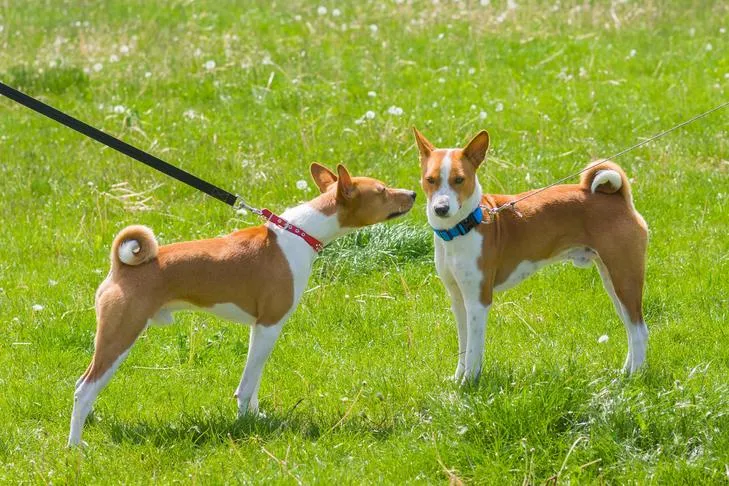Walking your dog should be an enjoyable experience for both of you, not a test of strength. Many dog owners face the common challenge of their furry companions pulling excessively on the leash, transforming a peaceful stroll into a strenuous struggle. This behavior isn’t just annoying; for larger dogs, it can even lead to injuries for the owner. Understanding why dogs pull and implementing effective training techniques can make a significant difference, helping you establish a harmonious walking routine. By focusing on consistent training and positive reinforcement, you can teach your dog to walk politely by your side, transforming walks from a drag into a delightful outing. This guide will provide you with 10 practical tips on how to train a dog to walk without pulling, ensuring you and your canine companion can enjoy your time together.
1. Always Reward Good Leash Behavior
It’s crucial never to take your dog’s good behavior for granted, especially when they are walking politely on a leash. Dogs naturally repeat behaviors that lead to rewarding outcomes, whether that reward comes in the form of a tasty treat, verbal praise, or the opportunity to explore an interesting smell. If your focus is primarily on correcting what your dog is doing wrong, and you overlook or take for granted the moments they behave well, your pet is more likely to revert to undesirable behaviors to get what they want.
Whenever your dog exhibits polite leash behavior, make sure to reinforce it with a suitable reward. Carry treats with you during walks or be ready with affectionate pets and encouraging words. Don’t be hesitant to show your appreciation for the behavior they choose to display. Initially, provide rewards frequently and generously. As your dog’s leash manners improve, you can gradually reduce the reliance on treats, substituting them with life rewards such as the chance to sniff a tree trunk or greet another friendly dog.
2. Never Let Your Dog Walk When They Are Pulling
The primary reason your dog pulls on the leash is often their innate desire to move forward and explore. If you allow them to continue walking while they are pulling, you are inadvertently providing them with the very reward they are seeking. This reinforces the pulling behavior, making it more challenging to correct in the long run. Therefore, it is essential never to proceed with the walk when your dog is tautening the leash. The moment your dog starts to pull, stop immediately, plant your feet firmly, and wait. Wait for your dog to either return to your side or for the tension on the leash to loosen.
 Basenjis meeting in a field outdoors, one on leash.
Basenjis meeting in a field outdoors, one on leash.
3. Wait for a Loose Leash Before You Walk
If you consistently stop every time your dog pulls, the key question becomes: how do you know when it’s appropriate to resume walking? The answer lies in waiting for a slack leash. The leash should hang loosely in a ‘J-shape’ and your dog should ideally turn their attention back to you. In the beginning, this waiting period might feel prolonged as your dog tries to figure out what’s happening. However, with consistency, your dog will eventually look back or walk towards you to understand why you’ve stopped. At this precise moment, offer praise and a treat positioned at your side, then calmly continue your walk. You might find yourself stopping and starting every step or two initially, but your dog will quickly learn that pulling brings the walk to a halt, while walking politely allows it to continue uninterrupted. This method helps reinforce that a loose leash is the key to forward movement.
4. Incorporate Life Rewards on Your Walk
Walks are much more than just a potty break; they should be a rich and engaging experience that provides both physical exercise and mental stimulation for your dog. During the early stages of training your dog not to pull, it can sometimes feel as though these enriching aspects are missing. A highly effective way to enhance your training and improve your dog’s overall walk experience is to integrate “life rewards” for adhering to the rules. Life rewards are the everyday pleasures your dog enjoys, such as the chance to sniff a fascinating shrub or to greet a friendly stranger. For instance, if your dog manages to walk a certain distance without pulling, you can release them for a few minutes to explore a scent or interact briefly. These bonus rewards serve as powerful motivators, truly convincing your dog that polite walking behavior yields significant benefits. This strategy creates a positive association with good leash manners.
5. Walk at a Good Pace
Often, the pace at which humans prefer to walk is considerably slower than what most dogs instinctively desire. Even smaller toy breeds can have a quicker gait than you might anticipate. This disparity in natural walking speeds is a common reason why dogs tend to pull – they simply want to move faster. To help your dog feel more engaged and less inclined to pull, try to choose a walking pace that is comfortable and enjoyable for both of you. While it is possible to teach your dog to match your exact speed, during the initial training phases, maintaining a quicker, more consistent pace can actually make it easier for them to learn not to pull on the leash. A brisk walk can keep them more focused and less likely to forge ahead independently.
6. Be Consistent With Your No-Pulling Rule
It can be incredibly tempting to make exceptions and let your dog pull on the leash, especially when you are pressed for time, perhaps running late for an appointment, or when the weather is unpleasant and you just want to finish the walk quickly. However, it is absolutely essential to maintain unwavering consistency with your no-pulling rule, regardless of the circumstances. Every single time you permit your dog to pull on the leash, you are effectively setting your training efforts back to square one. Until your dog consistently demonstrates good leash manners for more than just a few feet at a time, it’s advisable to limit their potty breaks to the yard or a very quick curb stop, and reserve longer walks for periods when you have ample time to dedicate to training without compromising your rules. This consistency is paramount for long-term success.
 Beagle pulling on the leash to sniff while on a walk outdoors.
Beagle pulling on the leash to sniff while on a walk outdoors.
7. Keep Training Sessions Short and Fun
Working with a dog that is a persistent leash-puller can be a source of significant frustration. In the early stages of training, you might find that you make very little progress, perhaps not even getting past the end of your driveway. Instead of pushing your dog until both of you become irritable due to a perceived lack of progress, it’s far more effective to keep your training sessions brief, positive, and enjoyable. Puppies, in particular, have very short attention spans, and demanding too much too soon is unlikely to yield the positive results you desire. Remember, your ultimate objective isn’t to cover a specific distance, but rather to achieve a walk with a loose leash, even if that means only making it to the house next door. Short, frequent, and fun sessions build a strong foundation. You can also work on commands like how to teach dog stay and come to improve their overall focus.
8. Be Interesting and Engaging on Walks
For dogs, the world is a vibrant and exciting place, brimming with new sights, intriguing sounds, and especially a multitude of captivating smells. These myriad stimuli constantly compete for your dog’s attention and can be powerful motivators for them to pull you down the sidewalk. If you are preoccupied with your phone or otherwise ignoring your dog during a walk, there’s little incentive for them to pay attention to you. However, if you make yourself interesting and engaging, your dog will be far more inclined to follow your lead. Talk to your dog, incorporate quick training breaks, stop for a brief game, or simply change directions unexpectedly. By keeping your dog guessing and engaged, they will be constantly waiting to see what exciting thing you will do next, making them more attentive to you rather than the distractions around them.
9. Stay Calm
 Cavalier King Charles Spaniel on a lead outdoors.
Cavalier King Charles Spaniel on a lead outdoors.
During walks, you and your dog can encounter a wide range of emotionally charged situations, from spotting their favorite neighbor at the end of the block to the sudden approach of a barking dog. Regardless of whether these encounters are exciting or frightening for your dog (and potentially for you), it is vital that you maintain control over your own emotions. Dogs are remarkably adept at reading human emotions, and your mood can readily transmit down the leash, impacting your dog. This can either escalate their excitement further or intensify any existing anxiety. To help your dog remain calm and composed, you must first stay calm yourself. By demonstrating a relaxed demeanor, you signal to your dog that there is nothing to be overly excited or worried about. The more relaxed your dog is, the more likely they will be able to listen to your commands and behave appropriately. This can also help with situations like how to stop dog barking when someone comes in.
10. Engage Your Dog In Distracting Situations
When faced with distractions like other dogs, squirrels, or even unfamiliar sounds, it’s incredibly easy for your dog to forget their leash manners and revert to pulling. The same applies to situations your dog finds suspicious or unsettling, such as encountering strangers who might make them nervous. In such scenarios, your dog might pull intensely, either to get closer to the distraction or to quickly move away from it. In either case, all the good leash manners you’ve been working on can quickly go out the window.
To help your dog navigate these distracting situations effectively, shift their focus back to you. Calmly offer them high-value treats or engage them in a simple game. For instance, ask for a “sit” or a “hand target.” These exercises are usually easy for your dog to perform and will keep them mentally engaged with you as the distraction passes. You can also teach your dog to make eye contact on command using a “watch me” cue, which gives you direct control over where they are looking. The key is to be proactive: anticipate potential distractions and grab your dog’s attention before they even spot what’s coming. With consistent practice, they may not even notice the distraction at all, maintaining their focus and polite leash walking.
By implementing these ten tips consistently, you can transform your walks from a challenging chore into a pleasant and rewarding experience for both you and your dog. Remember that patience, consistency, and positive reinforcement are the cornerstones of successful leash training. With time and dedication, you’ll soon be enjoying loose-leash walks, strengthening the bond with your canine companion.
